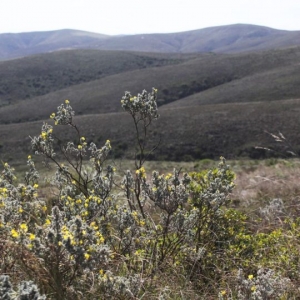The Renosterveld of the Overberg, of which the Overberg Renosterveld Conservation Trust are custodians, is one of the world’s most species diverse Mediterranean type shrublands. Just 4% of its former extent remains, making it one of the world’s most threatened ecosystems. The world’s largest contiguous stretches of Overberg Renosterveld, found at Haarwegskloof in the eastern Rûens was purchased by the World Wildlife Fund in 2013 and given to the Overberg Renosterveld Conservation Trust to manage.
Haarwegskloof Renosterveld Reserve and its visitor’s centre is one of the jewels in the crown of the Overberg’s stunning landscapes and biodiversity and receives numerous visitors from all over the world. The newly converted and spacious Old Dairy guest house offers comfortable and homely accommodation with a touch of luxury for nature lovers wanting to explore the 500 ha reserve and surrounding area. The old farmhouse has been converted into a purpose-built visitors’ centre that offers budget accommodation for all including a cohort of postgraduate students undertaking research into Renosterveld in the surrounding area.
The Overberg Renosterveld Conservation Trust is now launching a new interpreted walking trail on the Haarwegskloof Reserve for those visitors who wish to learn more about the unique biodiversity conserved here. The trail showcases the unique biodiversity and flora of the quartz patches of the eastern Rûens, home to several species new to science discovered and described by members of the ORCT. Visitors are rewarded by expansive views across the largest remaining area of Overberg Renosterveld in the world. The trail offers an easy walk taking about two hours to complete.
These quartz patches are found as ‘islands’ within a matrix of Shale Renosterveld vegetation in the Overberg’s eastern Rûens. They occur on similar geology to the quartz fields in the Knersvlakte in Namaqualand and in the Little Karoo but have only recently been recognised for their unique biodiversity and high levels of endemism with different species to the surrounding vegetation. Many of these plants are Red Listed as being threatened with extinction owing to extensive transformation for agriculture of most of this ecosystem. It is therefore a global conservation priority.
The Critically Endangered Polhillia curtisiae only grows here and on one nearby farm with the total world population of this species being thought to be no more than 100 plants. It is named after the founder and director of the Overberg Renosterveld Conservation Trust, Dr Odette Curtis. This species is a member of the Pea Family (Fabaceae) and is pollinated by bees and butterflies.
The bonsai-like prostrate Aspalathus quartzicola is also newly described in 2013 and is a member of the same genus as the plant used for making rooibos tea. The delicate white flowers (the size of matchstick heads) of this species have a sweet honey-like scent.
The Endangered Protea decurrens found here and just a handful of other sites has yeast-scented flowers produced at ground level that are pollinated by the Namaqua Rock Mouse.
Why not come and visit Haarwegskloof Renosterveld Reserve and learn more? We look forward to welcoming you to our beautiful and peaceful corner of the Overberg.










